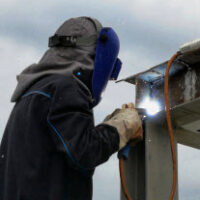The Three Most Dangerous Toxic Exposure Jobs

Workplace trauma injuries, like falls, happen suddenly and without warning. Occupational diseases, such as toxic exposure, occur slowly over time. In many cases, these diseases might take decades to fully develop. Until that time, many victims have little or no idea that they are sick at all.
Normally, strict time deadlines apply in these cases. Workers who do not quickly and properly report their injuries could lose their rights to obtain compensation. But these rules largely do not apply in occupational disease claims.
So, no matter how much time elapsed between the toxic exposure and the occupational disease diagnosis, a New Orleans workers’ compensation attorney might still be able to obtain financial compensation. Normally, this compensation includes lost wage replacement and medical bill payment. Generally, these benefits are retroactive to the date of toxic exposure.
Firefighters and Metallosis
Most people do not associate firefighters with metal blood poisoning. But the smoke that firefighters regularly inhale is usually laced with chromium, mercury, and other heavy metals.
It is often difficult to link toxic exposure diseases with a victim’s job environment. But in Louisiana, there is a presumption that firefighters who develop certain kinds of cancer were exposed to heavy metals and similar hazards while they were on the job.
Construction and Asbestos
These injuries are especially common among renovation and demolition construction workers. Residential and commercial structures built before 1980 almost always have asbestos. This mineral, which was used as fireproofing material, was quite cheap, very plentiful, very effective, and highly toxic. IN fact, just one microscopic asbestos fiber could cause one of several extremely serious illnesses.
Back in the day, a few builders invested in spray-on asbestos. This substance is not quite as dangerous as the fibrous asbestos which was much more common, especially in smaller construction projects. Today, many demolition and renovation workers are essentially unprotected from asbestos.
Mesothelioma, a rare and aggressive form of heart-lung cancer, is one of the most common effects of asbestos exposure. Cancerous tumors form in the delicate lining between the heart and lungs. As a result, these tumors are difficult to remove surgically or treat with radiation therapy or chemotherapy drugs. So, in advanced cases, doctors can often not do much more than make patients comfortable.
Unfortunately, by the time doctors confirm a mesothelioma diagnosis, the cancer is already in an advanced stage. The latency period could be up to forty years. And, once doctors identify the cancer, they often misdiagnose it as Non-Small Cell Lung Cancer, which is the most common kind of lung cancer.
Asbestos exposure could also cause asbestosis, a serious lung disease. The only effective treatment is a radical lung transplant, and only a few individuals are good candidates for such surgery.
Landscapers and Benzene
Some people believe that the smell of fresh-cut grass is intoxicating. They are right. But these people are smelling benzene as opposed to grass. Super-heated organic material, like yard clippings, release significant amounts of benzene fumes. These fumes are among the most toxic substances known to man.
A simple facemask often provides effective protection from benzene fumes. However, many employers do not provide them. Additionally, many Limited English Proficiency workers might not fully understand safety instructions, and therefore not fully understand the need for protection.
Count on a Dedicated Attorney
Toxic exposure could cause serious illnesses. For a free consultation with an experienced workers’ compensation lawyer in New Orleans, contact Lunsford, Baskin & Priebe, PLLC. We routinely handle matters in Louisiana and Mississippi.
Resource:
wcb.ny.gov/content/main/onthejob/OccDisease.jsp
